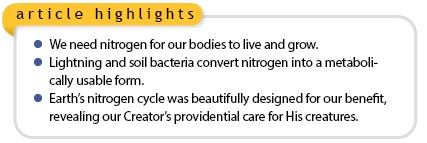 Nitrogen is vital for human survival, yet few appreciate how lightning and soil bacteria contribute to Earth’s nitrogen cycle.
Nitrogen is vital for human survival, yet few appreciate how lightning and soil bacteria contribute to Earth’s nitrogen cycle.
That Earth’s nitrogen cycle serves us as it does, reliably enabling our bodies to live and grow, proves God’s providential care for His creatures. To illustrate, we receive nitrogen in chemically usable forms whenever we consume fish, eggs, legumes, and/or dairy products.1,2
In contrast, consider how carbohydrate production is popularly appreciated. Photosynthesis is routinely taught in K-12 schools.3 But what about the nitrogen-containing foods our bodies need to build peptides for proteins and nucleotides for DNA and RNA? Because we need proteins, RNA, and DNA, we must constantly consume usable nitrogen in our diets.3
Although nitrogen is plentiful on Earth, not all forms are metabolically usable.2 Earth’s atmosphere is almost 80% nitrogen gas consisting of diatomic nitrogen (dinitrogen), but dinitrogen isn’t directly useful for building essential amino acids or nucleotides.2 So, we need providential processes to somehow solve that nutrition problem.
Thankfully, the greatest systems engineer, the Lord Jesus Christ, designed and programmed Earth’s nitrogen cycle, so gazillions of moving parts purposefully perform gazillions of nitrogen-harnessed services that benefit Earth’s ecosystems in general, as well as our bodies in particular.
For example, lightning breaks apart dinitrogen gas (which, apart from lightning’s heat and energy, is normally stable) in the atmosphere to recombine nitrogen and oxygen into nitrogen oxides such as NO and NO2. If raincloud moisture (H2O) interacts with nitrogen oxides so that acidic hydrogen is bonded, nitrous acid (HNO2) or nitric acid (HNO3) can result, falling into soil and allowing water-soluble nitrates (NO3-) to form as “fixed” nitrogen.2
Much more nitrogen-fixing is accomplished by “nitrifying” soil bacteria (e.g., Azotobacter or Rhizobium) or cyanobacteria (e.g., Anabaena) that quietly convert nitrogen gas into usable nitrogen compounds (N2 → N3, then N3 + O2 → NO2- or NO3-) in ongoing chemical reactions that busily occur 24/7 at microscopic levels—often in symbiotic relationships between fungi and leguminous plants.4
Meanwhile, Earth’s global nitrogen cycle requires a systematically dynamic equilibrium, so counterbalancing denitrifying processes are also needed.
Some bacteria are constantly “fixing” nitrogen into an absorbable form, while other types of bacteria are constantly “denitrifying” it into a gas [N2]. These processes balance one another to maintain life-appropriate amounts of both absorbable and inert nitrogen.2
As ICR’s Dr. Brian Thomas observed, this systems-engineering operation is purposeful and well-balanced.
At the smallest level, the enzymatic machinery in each kind of bacterium is stunningly well-engineered. At a much larger level, the continued maintenance of the overall nitrogen cycle by soil bacteria in varying environments is a well-designed meta-system. And all of it had to be put in place at the same time in the beginning in order for life to exist, just as Scripture teaches.2
But there’s more. Nitrogen cycle eco-engineering is not limited to producing nutritional health benefits. In the case of  Texas bluebonnets (Lupinus texensis)—a nitrogen-fixing leguminous lupine—God clothes eco-engineering with brilliant beauty beyond that of King Solomon’s most glorious garments.4
The engineering and artistry surrounding us reveal the glory of our Creator Jesus Christ’s handiwork. We just have to look to see it.
References
- Acts 14:17 (food demonstrates God’s caring providence); Luke 11:11-13 (fish and poultry eggs are good sources of nutrition); 1 Peter 2:2 (milk is good for growth).
- Thomas, B. New Insights into Earth’s Nitrogen-Balancing System. Creation Science Update. Posted on ICR.org November 21, 2011, accessed May 5, 2022; Hill, R. D., R. G. Rinker, and H. D. Wilson. 1980. Atmospheric Nitrogen Fixation by Lightning. Journal of the Atmospheric Sciences. 37 (1): 179-192.
- Sunlight energy is harnessed by chlorophyll-equipped plants to produce organic carbon products that we need, such as carbohydrates (like sugars and starches). It’s an oversimplification fallacy to say human diets mostly need food energy via carbohydrate consumption, yet food pyramids promoted during the 20th century misleadingly promoted that error. E.g., see Nestle, M. 1993. Food Lobbies, the Food Pyramid, and U.S. Nutrition Policy. International Journal of Health Services. 23 (3): 483-496.
- Johnson, J. J. S. It’s Bluebonnet Season! Creation Science Update. Posted on ICR.org April 3, 2020, accessed May 5, 2022. See also Matthew 6:28b-29 and Luke 12:27.
* Dr. Johnson is Associate Professor of Apologetics and Chief Academic Officer at the Institute for Creation Research.












